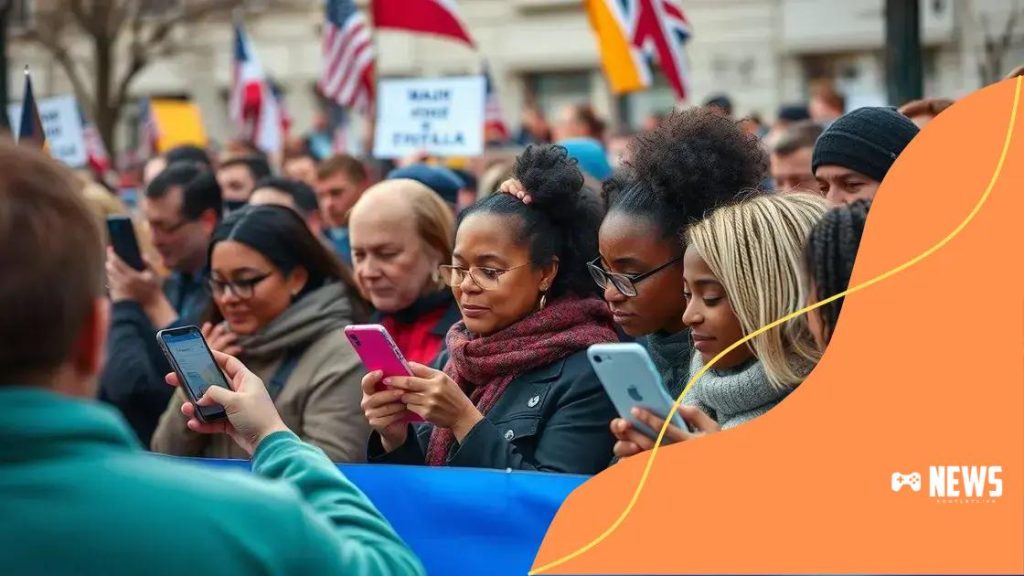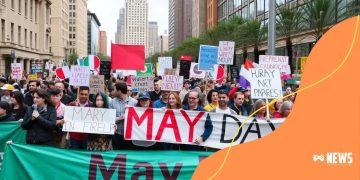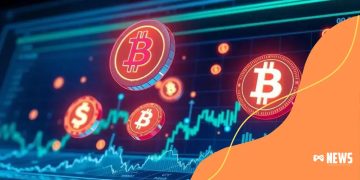The influence of social media on political movements

The influence of social media on political movements allows activists to mobilize quickly, communicate effectively, and engage worldwide, but it also presents challenges such as misinformation and online harassment.
The influence of social media on political movements is undeniable. It’s transforming the way we communicate about issues that matter. Have you ever considered how a single tweet can spark a revolution?
Understanding the role of social media
Understanding the role of social media is essential in today’s digital landscape. Social media platforms have become places where people share ideas, organize movements, and influence political change.
These platforms allow users to voice their opinions and mobilize others quickly. The speed and accessibility of social media can make a significant difference in how movements gain traction. A single post can go viral and reach thousands, or even millions, of people in a matter of hours.
The power of hashtags
Hashtags are a powerful tool on social media. They help users find relevant content and connect with others who share their interests. For example, during political protests, hashtags can unite various groups and raise awareness.
- Hashtags increase visibility for movements.
- They encourage participation from a broader audience.
- They can create a sense of community among supporters.
Engaging with a global audience
Social media breaks down geographic barriers. Activists can communicate with supporters worldwide, creating a global solidarity that was challenging to achieve before. Many movements utilize platforms like Twitter and Instagram to share real-time updates and connect with international audiences, fostering global participation.
Furthermore, social media often provides a space for marginalized voices. Activists can share their stories and experiences without being filtered by traditional media outlets. This direct communication empowers communities and raises awareness about issues that might otherwise be overlooked.
Challenges and risks involved
While social media has incredible advantages, it also comes with risks. Misinformation can spread rapidly, potentially harming movements. Additionally, activists might face online harassment or censorship from authorities.
- Understanding risks is crucial for effective advocacy.
- Activists must advocate for online safety and privacy.
- Training on digital literacy can help navigate challenges.
Despite these risks, the potential for positive change through social media remains strong. By harnessing its power effectively, movements can reshape the political landscape and encourage civic engagement.
Case studies: Successful movements
Exploring case studies of successful movements provides valuable insights into the effectiveness of social media. Many movements have effectively harnessed the power of social media to foster change, making it crucial to understand what worked in each scenario.
One notable example is the Arab Spring, where social media played a pivotal role in organizing protests and sharing information. Activists used platforms like Facebook and Twitter to spread awareness quickly. This grassroots movement showed how social media could empower individuals to challenge oppressive regimes.
Key factors that contributed to success
Several elements contributed to the effectiveness of these movements:
- Real-time communication: Social media enabled instant information sharing.
- Mobilization: Activists rallied supporters using hashtags and viral posts.
- Global awareness: International support grew through online platforms, attracting media attention.
Another example is the Black Lives Matter movement. Social media became a platform for advocating against racial injustice. The hashtag #BlackLivesMatter united voices across different demographics, making it a powerful tool for mobilization.
The movement utilized social media to share personal experiences, educating the public about systemic racism. By posting videos and stories, activists raised awareness and sparked conversations that were previously ignored. This approach built solidarity among supporters, creating a sense of community online.
Lessons learned from these movements
Analyzing these successful movements emphasizes the importance of strategy. Understanding the audience is key to engaging supporters effectively. It is also essential to remain adaptable, as new platforms and features emerge.
- Utilizing visuals: Compelling images and videos enhance engagement.
- Staying informed: Movements must keep up with trends to maximize impact.
- Building networks: Collaborating with other organizations strengthens campaigns.
The role of grassroots organizing is undeniable. Effective use of social media aided in mobilizing communities and enhancing visibility for causes. These case studies highlight possibilities and inspire future movements to leverage social media for positive change.
How social media affects public opinion

Understanding how social media affects public opinion is critical in our fast-paced digital world. Social media platforms serve as a hub for sharing thoughts, news, and personal experiences, shaping how people perceive various issues.
The algorithms used by these platforms can determine which stories gain visibility, influencing what users see and, ultimately, how they think. This exposure can create echo chambers, where individuals are only exposed to viewpoints that reinforce their beliefs, which can skew public opinion significantly.
The impact of trending topics
Trending topics often reflect what users are currently discussing. These topics can rapidly change public perceptions, sometimes based on the latest news or viral posts. Such dynamics show how swiftly information can shift opinions.
- Instant feedback: Users can express their views immediately on trending topics.
- Viral messages: Content can spread rapidly, influencing a large audience.
- Influencer involvement: Public figures can sway audience opinions with a single post.
Another vital aspect is the power of user-generated content. Regular individuals can contribute to discussions, influencing their peers and informing broader communities. When users share personal stories or experiences related to significant issues, these narratives often resonate deeply and can foster empathy among their audiences.
Misinformation and its effects
However, the power of social media is a double-edged sword. Misinformation can spread just as quickly as factual content. False claims can shape public opinion, leading to unrest and confusion. Users must be aware of their sources and verify facts before sharing.
- Critical thinking: Users need skills to evaluate the information they encounter.
- Responsible sharing: It’s essential to spread verified information rather than rumors.
- Evolving narratives: Understanding how narratives change is crucial for informed discussions.
Moreover, the role of memes and creative content cannot be overlooked. Humor and relatability can make messages more accessible, spreading ideas engagingly. Memes often capture complex subjects in digestible formats, enabling rapid interactions that can influence how people feel about specific topics.
Challenges faced by activists online
Activists face numerous challenges online that can hinder their efforts. While social media provides a platform for organization and awareness, it also poses risks that can impact effectiveness.
One major challenge is online harassment. Activists often receive threats and negative comments that can deter their participation and affect mental health. This kind of environment can limit the voices of those who are most passionate about advocating for change.
The risk of misinformation
Misinformation can undermine the goals of activists. False claims can spread rapidly, causing confusion and damaging reputations.
- Verified information: Ensure all shared content is credible.
- Social media algorithms: These can amplify false narratives, complicating discussions.
- Public perception: Misunderstandings can lead to decreased support for movements.
Additionally, activists must navigate censorship. Some platforms may restrict content that challenges the status quo or goes against community guidelines. This can limit visibility for critical issues, making it difficult for activists to reach their audience.
Digital divide and access issues
The digital divide is another challenge. Not everyone has equal access to technology or the internet. This gap can exclude many potential supporters from joining movements or expressing their opinions.
- Technology literacy: Some may lack the skills to engage effectively online.
- Economic barriers: High costs of devices or internet may prevent participation.
- Geographic limitations: Rural areas may have inadequate internet service.
Finally, the fast-paced nature of social media can be overwhelming. Activists must continually stay informed and adapt strategies to engage audiences effectively. This pressure can lead to burnout, hindering the long-term sustainability of movements.
The future of activism in the digital age
The future of activism in the digital age is promising yet filled with factors that will shape its trajectory. As technology evolves, so do the tools and strategies used by activists. Online platforms offer unique opportunities to reach wider audiences and mobilize support quickly.
One significant aspect of this future is the increasing use of artificial intelligence. AI can help analyze data, track social media trends, and identify key influencers. By harnessing AI, activists can streamline their campaigns and enhance outreach.
The rise of decentralized movements
Decentralization is becoming a key trend in modern activism. Rather than relying on a single leader or organization, movements are relying on networks of individuals. This approach fosters resilience and adaptability, making it harder for authorities to disrupt.
- Community-driven initiatives: Local groups can lead efforts that resonate closely with their communities.
- Global solidarity: Activists can connect across borders, sharing strategies and resources.
- Flexibility: Decentralized movements can pivot quickly in response to changing circumstances.
Moreover, virtual reality (VR) and augmented reality (AR) are opening new avenues for engagement. Activists can create immersive experiences that educate and engage audiences in unique ways. These technologies can bring attention to critical issues by allowing people to experience events from different perspectives.
Building digital literacy
As activism becomes increasingly digital, enhancing digital literacy is crucial. Individuals must be able to navigate online spaces safely and effectively. This includes understanding privacy settings, recognizing misinformation, and engaging responsibly. Education around digital literacy will empower more people to participate actively in online campaigns.
- Workshops and training: Organizations can offer resources to improve skills.
- Encouraging critical thinking: Learners can develop the ability to assess information source quality.
- Promoting safe online practices: Techniques to protect personal data and online identities should be emphasized.
Ultimately, the role of social media in activism will continue to grow. While challenges exist, the opportunities for fostering change through digital means are vast. Creatively engaging with technology will empower activists to drive meaningful change in society.
The future of activism in the digital age is bright but requires adaptability and awareness of new challenges. As technology evolves, activists must embrace innovative tools to enhance their reach and effectiveness. Understanding how to navigate social media, utilize AI, and ensure digital literacy will empower movements to foster impactful change. The rise of decentralized networks can strengthen activism by creating unity among diverse voices. Overall, the digital age presents both exciting opportunities and hurdles for activists, making it essential to stay informed and engaged.
FAQ – Frequently Asked Questions about the Future of Activism in the Digital Age
How can AI enhance activism efforts?
AI can analyze trends and data, helping activists optimize their campaigns and reach a wider audience effectively.
What does decentralization mean for social movements?
Decentralization allows movements to operate without a single leader, fostering resilience and enabling diverse voices to be heard.
Why is digital literacy important for activists?
Digital literacy helps activists navigate online platforms safely, recognize misinformation, and engage effectively with their audience.
How can activists address misinformation in their campaigns?
Activists should verify facts before sharing information and educate their followers on identifying credible sources to maintain trust.





